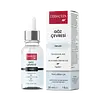What's inside
What's inside
 Key Ingredients
Key Ingredients

 Benefits
Benefits

 Concerns
Concerns

 Ingredients Side-by-side
Ingredients Side-by-side

C8-12 Acid Triglyceride
Skin ConditioningIsohexadecane
EmollientGlycol
HumectantButyrospermum Parkii Butter
Skin ConditioningCetearyl Alcohol
EmollientAloe Barbadensis Extract
Skin ConditioningGlyceryl Stearate
EmollientPEG-100 Stearate
Cyclopentasiloxane
EmollientDi-C12-13 Alkyl Malate
EmollientTocopheryl Acetate
AntioxidantPrunus Armeniaca Kernel Oil
MaskingAllantoin
Skin ConditioningMagnesium Aluminum Silicate
AbsorbentCamellia Sinensis Leaf Extract
AntimicrobialHamamelis Virginiana Leaf Extract
Skin ConditioningPanthenol
Skin ConditioningSodium Ascorbyl Phosphate
AntioxidantSodium Hyaluronate
HumectantAesculus Turbinata Bark
Skin ConditioningC8-12 Acid Triglyceride, Isohexadecane, Glycol, Butyrospermum Parkii Butter, Cetearyl Alcohol, Aloe Barbadensis Extract, Glyceryl Stearate, PEG-100 Stearate, Cyclopentasiloxane, Di-C12-13 Alkyl Malate, Tocopheryl Acetate, Prunus Armeniaca Kernel Oil, Allantoin, Magnesium Aluminum Silicate, Camellia Sinensis Leaf Extract, Hamamelis Virginiana Leaf Extract, Panthenol, Sodium Ascorbyl Phosphate, Sodium Hyaluronate, Aesculus Turbinata Bark
Ingredients Explained
These ingredients are found in both products.
Ingredients higher up in an ingredient list are typically present in a larger amount.
Panthenol is a common ingredient that helps hydrate and soothe the skin. It is found naturally in our skin and hair.
There are two forms of panthenol: D and L.
D-panthenol is also known as dexpanthenol. Most cosmetics use dexpanthenol or a mixture of D and L-panthenol.
Panthenol is famous due to its ability to go deeper into the skin's layers. Using this ingredient has numerous pros (and no cons):
Like hyaluronic acid, panthenol is a humectant. Humectants are able to bind and hold large amounts of water to keep skin hydrated.
This ingredient works well for wound healing. It works by increasing tissue in the wound and helps close open wounds.
Once oxidized, panthenol converts to pantothenic acid. Panthothenic acid is found in all living cells.
This ingredient is also referred to as pro-vitamin B5.
Learn more about PanthenolSodium Hyaluronate is hyaluronic acid's salt form. It is commonly derived from the sodium salt of hyaluronic acid.
Like hyaluronic acid, it is great at holding water and acts as a humectant. This makes it a great skin hydrating ingredient.
Sodium Hyaluronate is naturally occurring in our bodies and is mostly found in eye fluid and joints.
These are some other common types of Hyaluronic Acid:
Learn more about Sodium Hyaluronate